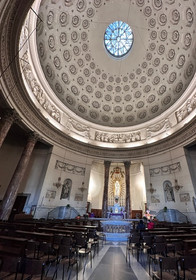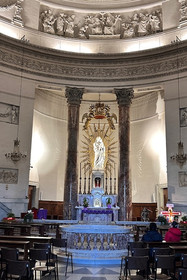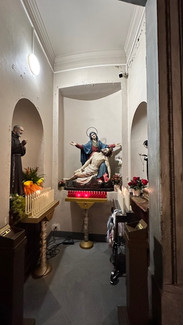Great Mother of God – Gran Madre di Dio
- Maria Scuor
- Feb 3
- 9 min read
Updated: Feb 4
Scorri a basso per l’italiano
Based on Wikipedia Commons there are 183 different churches in the metropolitan city of Turin, or Torino in Italian. Of these 102 are located in Torino. We had the pleasure of visiting five in total and in this blog, I provide the mystery surrounding the Great Mother of God or Gran Madre di Dio.
As we walked through Piazza Vittorio Veneto and got near the Po River, we could see across the Po and the Victor Emmanuel I bridge, this amazing building that we didn’t know what it was. Gran Madres di Dio church is a Neoclassic-style church that is dedicated to Mary, Mother of God.
This church or temple was conceived after the defeat of Napoleon and the return to the throne of King Victor Emmanuel I of Sardinia in 1814. He had been in exile for 16 years. It wasn’t until 1818 that construction began when architect Ferdinando Bonsignore won the competition for his vision of the church. However, there was a pause that restarted in 1827, under the rule of new King Charles Felix of Sardinia. The church was finally inaugurated and consecrated by King Charles Albert of Sardinia in 1831, however it was never owned by they church, instead it is owned by the municipality.
The square the church stands on is big and required for the stature of it. The almost 10 meter / 32.8 ft tall statue of marble in front of the church, at the bottom of the stairs, represents King Victor Emmanuel I of Savoy. From a distance and at the entrance we can easily see the Latin inscription “ORDO POPULUSQUE TAURINUS OB ADVENTUM REGIS” which translates to “The nobility and people of Torino for the return of the King”. It was to pay homage to the return of Victor Emmanuel I.
Because of its style and the lack of Christian symbolism, people are inclined to view the Gran Madre Church as a temple more than a church. It strongly resembles the Pantheon in Rome and there is no doubt, it passes as an ancient Roman temple dedicated to all Gods.
The grand staircase is beyond the fencing and on either side of it are two statues. Both were sculptured by Carlo Chelli and have created the mystery that surrounds the Church of Gran Madre.
The statue to the right is the statue of Religion and has a woman dressed in long dress and a cloak that falls to the ground. At her side is a young man who offers her some stone tablets but there are no inscriptions and the statue points to them. In her right-hand Religion holds a Latin cross taller than her. This is the only cross present in the entire church. This very detail could mean the church has esoteric tendencies, white and black magic. In the center of Religion’s forehead is a triangle with an eye, which represents the gaze of God in all directions and at the foot of the statue is a papal tiara, perhaps to symbolize the fall of the power of the Church and the coming of other, mysterious forces. The statue looks out toward the city.
The statue on the left is Faith and is dressed almost as Religion however there is no symbol on her forehead. She too is looking toward the city. In her right hand she holds a book, to hint there is a hidden truth and on the left she holds a chalice. The chalice, is the object of mystery because according to interpretations, it represents the Holy Grail, and it is believed her gaze towards the city, points to where in the city the Grail is hidden. However, Faith has no pupils, therefore impossible to pinpoint the true location.
The perceived symbolism suggests it is a construction tied to mystery and esotericism. Therefore, many in Torino call it a place of the ‘Black Torino.’ But because many of the positive details balance the occult signs other call it “White Torino.” The mystery lies before us, is it black or is it white?

When you walk up the stairs you see the first six column pronaos, these form the portico in front of the church. You also see four more columns to the left of the entrance. They are stunning and above them in the triangular top part is a bas relief sculpted in 1827, portraying the Holy Virgin with Child paid homage by the Torino decurions who sponsored the church.
This church doesn’t have a bell tower however, you can see to the right of the church there is a neo-baroque tower which was built in 1830 where the church offices, archives and youth club is located.
When we walked inside, I expected something grandiose, but unlike the other churches in Italy we saw the Gran Madre is very simple. It has a single circular nave with the main altar located on the right inside an apsis. It has two large red porphyry columns, opposite the other two similar ones that flank the entrance. Behind the altar there is a famous statue of the Holy Mary with the Child surrounded by a mystical aura made up of golden rays and surmounted by a large wooden crown supported by two cherubs,
In rooms below the nave is the crypt designed by Giovanni Ricci, is the Shrine to the 4000 Fallen Soldiers of the First World War. It was inaugurated on 25 October 1932, in the presence of Benito Mussolini.
The most important and really cool part of the church is the dome. It has five orders of octagonal coffers, which decrease in size and is decorated in stucco. This is considered a masterpiece of Piedmontese neoclassicism; the structure is entirely made of concrete and ends with a circular oculus of over three metres in diameter from which the zenithal light filters. The oculus was designed in such a way that the light coming from it illuminates the statue of John the Baptist on the day of his feast, 24 June. Now that is cool!
At the base of the dome there is are sculpted garlands alternating with four bas-reliefs which narrate episodes from the Life of the Virgin, namely: Nativity, Presentation at the Temple, Marriage and Coronation.
In the internal lateral niches, there are statues of: Saint Maurice, the blessed Margaret of Savoy, the blessed Amadeus IX of Savoy and Saint John the Baptist, patron saint of the city. Only in the twentieth century a large crucifix by the sculptor Edoardo Rubino and a bas-relief by Umberto Baglioni were added.
Church or Temple, Black or White, the history behind this building leaves us wanting to know more about it. But it will remain the mystery that it is. Definitely a must see when in Torino.
Exterior - Esterno
Interior - Interno
Gran Madre di Dio
Sulla base di Wikipedia Commons ci sono 183 chiese diverse nella città metropolitana di Torino. Di questi, 102 si trovano a Torino. Abbiamo avuto il piacere di visitarne cinque in totale e in questo blog vi racconto il mistero che circonda la Gran Madre di Dio.
Mentre attraversavamo Piazza Vittorio Veneto e arrivavamo vicino al fiume Po, potevamo vedere oltre il Po e il ponte Vittorio Emanuele I, questo incredibile edificio che non sapevamo cosa fosse. La chiesa della Gran Madre di Dio è una chiesa in stile neoclassico dedicata a Maria, Madre di Dio.
Questa chiesa o tempio fu concepita dopo la sconfitta di Napoleone e il ritorno al trono del re Vittorio Emanuele I di Sardegna nel 1814. Era in esilio da 16 anni. Fu solo nel 1818 che iniziò la costruzione quando l'architetto Ferdinando Bonsignore vinse il concorso per la sua visione della chiesa. Ci fu però una pausa che ricominciò nel 1827, sotto il governo del nuovo re Carlo Felice di Sardegna. La chiesa fu finalmente inaugurata e consacrata dal re Carlo Alberto di Sardegna nel 1831, tuttavia non fu mai di proprietà della chiesa, ma è di proprietà del comune.
La piazza su cui sorge la chiesa è grande e richiede la sua statura. La statua di marmo alta quasi 10 metri di fronte alla chiesa, in fondo alle scale, rappresenta il re Vittorio Emanuele I di Savoia. Da lontano e all'ingresso possiamo facilmente notare la scritta latina "ORDO POPULUSQUE TAURINUS OB ADVENTUM REGIS" che si traduce in "La nobiltà e il popolo di Torino per il ritorno del Re". Era per rendere omaggio al ritorno di Vittorio Emanuele I.
A causa del suo stile e della mancanza di simbolismo cristiano, le persone sono inclini a vedere la Chiesa della Gran Madre come un tempio più che una chiesa. Assomiglia molto al Pantheon di Roma e non c'è dubbio, passa per un antico tempio romano dedicato a tutti gli Dei.
Lo scalone d'onore si trova oltre la recinzione e ai lati di esso si trovano due statue. Entrambe sono state scolpite da Carlo Chelli e hanno creato il mistero che avvolge la Chiesa della Gran Madre.
La statua a destra è la statua della Religione e ha una donna vestita con un lungo abito e un mantello che cade a terra. Al suo fianco c'è un giovane che le offre alcune tavolette di pietra ma non ci sono iscrizioni e la statua le indica. Nella sua mano destra la Religione tiene una croce latina più alta di lei. Questa è l'unica croce presente in tutta la chiesa. Questo stesso dettaglio potrebbe significare che la chiesa ha tendenze esoteriche, magia bianca e nera. Al centro della fronte della Religione c'è un triangolo con un occhio, che rappresenta lo sguardo di Dio in tutte le direzioni e ai piedi della statua c'è una tiara papale, forse per simboleggiare la caduta del potere della Chiesa e l'arrivo di altre forze misteriose. La statua si affaccia verso la città.
La statua a sinistra è la Fede ed è vestita quasi da Religione, tuttavia non c'è alcun simbolo sulla sua fronte. Anche lei guarda verso la città. Nella mano destra tiene un libro, per suggerire che c'è una verità nascosta e nella sinistra tiene un calice. Il calice, è oggetto di mistero perché secondo le interpretazioni, rappresenta il Santo Graal, e si crede che il suo sguardo verso la città, indichi dove nella città è nascosto il Graal. Tuttavia, la fede non ha pupille, quindi è impossibile individuare la vera posizione.
Il simbolismo percepito suggerisce che si tratti di una costruzione legata al mistero e all'esoterismo. Per questo molti a Torino lo chiamano il luogo della "Torino Nera". Ma poiché molti dei dettagli positivi bilanciano i segni occulti, altri la chiamano "Torino Bianca". Il mistero è davanti a noi, è nero o è bianco

Salendo le scale si vedono i primi sei pronai a colonna, che formano il portico antistante la chiesa. Si vedono anche altre quattro colonne a sinistra dell'ingresso. Sono stupende e sopra di esse, nella parte superiore triangolare, si trova un bassorilievo scolpito nel 1827, raffigurante la Santa Vergine col Bambino omaggiata dai decurioni torinesi che patrocinarono la chiesa.
Questa chiesa non ha un campanile, tuttavia, si può vedere che a destra della chiesa c'è una torre neobarocca che è stata costruita nel 1830 dove si trovano gli uffici della chiesa, gli archivi e il club giovanile.
Quando siamo entrati mi aspettavo qualcosa di grandioso, ma a differenza delle altre chiese in Italia abbiamo visto che la Gran Madre è molto semplice. Presenta un'unica navata circolare con l'altare maggiore situato a destra all'interno di un'abside. Presenta due grandi colonne di porfido rosso, contrapposte alle altre due simili che fiancheggiano l'ingresso. Dietro l'altare si trova una famosa statua della Madonna col Bambino circondata da un'aura mistica composta da raggi dorati e sormontata da una grande corona lignea sorretta da due putti.
Nei locali sottostanti la navata si trova la cripta progettata da Giovanni Ricci, si trova il Sacrario dei 4000 caduti della Prima Guerra Mondiale. Fu inaugurato il 25 ottobre 1932, alla presenza di Benito Mussolini.
La parte più importante e davvero interessante della chiesa è la cupola. Presenta cinque ordini di cassettoni ottagonali, che decrescono di dimensioni ed è decorato a stucco. Questo è considerato un capolavoro del neoclassicismo piemontese; La struttura è interamente in cemento e termina con un oculo circolare di oltre tre metri di diametro da cui filtra la luce zenitale. L'oculo è stato progettato in modo tale che la luce che ne proviene illumini la statua di Giovanni Battista nel giorno della sua festa, il 24 giugno. Ora che figata!
Alla base della cupola si trovano ghirlande scolpite alternate a quattro bassorilievi che narrano episodi della Vita della Vergine, ovvero: Natività, Presentazione al Tempio, Matrimonio e Incoronazione.
Nelle nicchie laterali interne si trovano le statue di: San Maurizio, la beata Margherita di Savoia, il beato Amadeo IX di Savoia e San Giovanni Battista, patrono della città. Solo nel Novecento si aggiunsero un grande crocifisso dello scultore Edoardo Rubino e un bassorilievo di Umberto Baglioni.
Chiesa o tempio, bianco o nero, la storia dietro questo edificio ci lascia con la voglia di saperne di più. Ma rimarrà il mistero che è. Sicuramente una tappa obbligata quando si è a Torino.
















































Comments